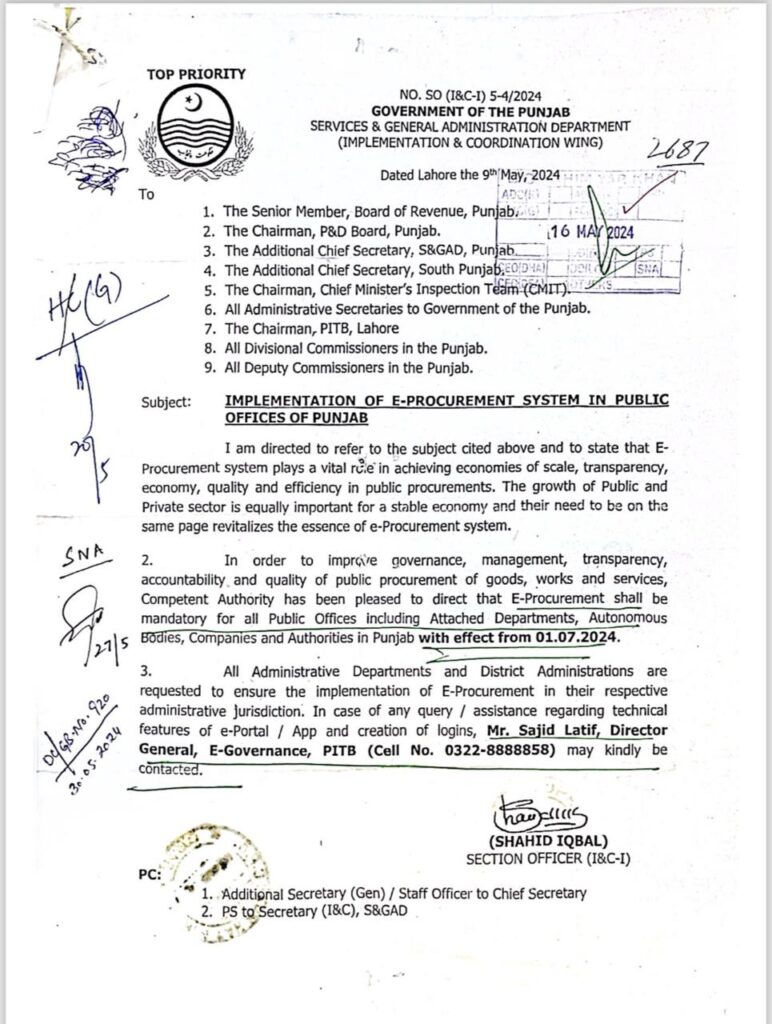
Implementation of E-Procurement System in Public Offices of Punjab dt 09.05.2024
OFFICE MEMORANDUM
Subject: Implementation of E-Procurement System in Public Offices of Punjab
I am directed to refer to the subject cited above and to state that the E- Procurement system plays a vital role in achieving economies of scale, transparency, economy, quality and efficiency in public procurements. The growth Public and Private sectors are equally important for a stable economy and their need to be on the same page revitalizes the essence of the e-Procurement system.
- In order to improve governance, management, transparency, accountability and quality of public procurement of goods, works and services, Competent Authority has been pleased to direct that E-Procurement shall be mandatory for all Public Offices including Attached Departments, Autonomous Bodies, Companies and Authorities in Punjab with effect from 01.07.2024.
- All Administrative Departments and District Administrations are requested to ensure the implementation of E-Procurement in their respective administrative jurisdiction. In case of any query / assistance regarding technical features of e-Portal / App and creation of logins, Mr. Sajid Latif, Director General, E-Governance, PITB (Cell No. 0322-8888858) may kindly be contacted.
Objectives of E-Procurement
The main goal of implementing the e-procurement system is to bring transparency to public procurement activities. Public offices often deal with large volumes of contracts and purchases, and there is always the risk of mismanagement, fraud, or favoritism. An online platform reduces human intervention, making the process more objective.
Another important objective is to speed up the procurement process. Traditional methods of buying goods or services involved multiple steps like issuing tenders, inviting bids, reviewing them manually, and finalizing contracts. These steps can now be done through a digital platform, saving time and reducing errors.
Key Features of the E-Procurement System
- Digital Tendering: Tenders are now issued and submitted electronically, reducing the need for physical submissions and paperwork. This makes the tendering process more transparent as all bidders have equal access to the system.
- Automation: The system automates various tasks such as bid submission, evaluations, and contract awarding, which were previously handled manually.
- Transparency: The e-procurement platform ensures that all activities are recorded and can be audited. This reduces the scope for any manipulation or favoritism in the bidding process.
- Cost and Time Efficiency: It reduces the overall cost associated with printing, mailing, and delivering tender documents. The automated system also allows for quicker evaluations and decisions, saving valuable time.
- Security: The platform is designed with security protocols to protect sensitive information. This ensures that bidder information and submitted bids are secure.
- Monitoring and Reporting: The system allows for real-time tracking of procurement activities, offering detailed reports to monitor spending, progress, and compliance with rules.
Benefits
- Reduction in Corruption: Since all tenders and bids are managed digitally, it leaves very little room for human intervention, reducing the chances of corruption or favoritism.
- Improved Vendor Participation: Vendors can submit their bids from any location without the need to visit offices physically. This encourages more participation and competition, ensuring the best value for money for the government.
- Faster Processes: Automation speeds up various steps in procurement, such as bid evaluations, allowing public offices to make decisions faster and without delays.
- Paperless Workflows: The system eliminates the need for paperwork, making the entire process environmentally friendly and reducing office overhead costs.
- Compliance and Accountability: The system logs every action taken during the procurement process, making it easy to audit and review. This enhances accountability as every action can be traced back to responsible individuals.
Challenges
While the e-procurement system brings many benefits, there are some challenges associated with its implementation:
- Technological Literacy: Public officials and vendors may initially struggle with using the new system, requiring training and support.
- Infrastructure: Reliable internet access and technological infrastructure are necessary for the system to function effectively, especially in remote areas.
- Resistance to Change: Some public offices or individuals might resist the transition from traditional methods to the new system due to comfort with old practices.
Conclusion
The implementation of the E-Procurement System in public offices of Punjab is a forward-thinking initiative aimed at enhancing transparency, efficiency, and accountability in public procurement. It marks a move away from traditional, paper-based, and manual processes that were prone to inefficiencies and corruption. By introducing a digital platform, the government can ensure that all procurement activities are fair, quick, and cost-effective. While there may be some initial challenges, such as training and infrastructure development, the long-term benefits far outweigh these difficulties. As more public offices adopt this system, it will likely become the standard for procurement, contributing to better governance and improved public service delivery in Punjab.

